Paisley District Tramways
History
The genesis of Paisley's electric tramway system is somewhat convoluted, with several competing schemes, an ailing horse tramway — owned by the Paisley Tramway Company — and a local authority, Paisley Town Council, which simply couldn't make its mind up.
The saga began on the 15th February 1897 with an Extraordinary General Meeting of the PTCo, at which it was announced that the directors had negotiated an agreement for the British Electric Traction Company to take over the horse tramway and convert it to electric traction, and also, to pay off the outstanding debt. The shareholders seemed unlikely to get a better offer for their small tramway, so readily agreed to the new deal, the BETCo effecting a conditional takeover from the 1st January 1898. The BETCo was a major player in the expanding electric tramway world, and was at that time aggressively purchasing horse and steam-operated tramways across the British Isles with the intention of converting them to electric traction, as well as promoting schemes for completely new electric tramways. At its zenith, it would either own, part-own or lease around fifty tramway concerns across the country.
The BETCo's plans were, however, opposed by Glasgow Corporation, which was determined to extend its own system from the city boundary into central Paisley, and had the support of Renfrew County Council. As for Paisley Town Council, everything seemed to be happening too quickly for its liking, and though the councillors were disinclined to have Glasgow Corporation tramcars in their burgh, they weren't ready to fully support the BETCo either, as a result of which the latter's application for a Light Railway Order (in 1898) failed. This was much to the consternation of the burghs to the west of Paisley, which the proposed BETCo tramway system would have served. Despite this, the BETCo persevered, bringing revised plans before the council in 1899, only for the council to then start a dalliance with another promoter, William Martin Murphy, who had close connections to the British Thomson-Houston Company. The council could not seem to make up its mind for more than a week at a time, first opposing Murphy's scheme, before briefly supporting it, only to then oppose it once again, before eventually supporting it again, though only in principle, all these machinations taking place in a matter of weeks in January and February 1900. The BETCo had clearly had enough of the council, which couldn't be trusted to maintain an opinion from one week to the next, so it formally withdrew its proposals in March 1900, leaving the PTCo without a buyer, the sale almost certainly having been conditional on a successful outcome for the electrification scheme.
The PTCo soldiered on, its vehicles in ever more decrepit condition, presumably hoping that either Murphy or the council would eventually buy them out. However, the latter's vacillations continued, with Murphy applying for parliamentary powers to construct 19.66 miles of electric tramway in spite of its opposition. A sense of how weary officialdom had become with the council's shenanigans, can be gleaned from the fact that parliament voted to approve Murphy's bill, which was passed into law on the 17th August 1901 (under the Paisley District Tramways Order Confirmation Act, 1901), purportedly making it the first tramway bill in the British Isles to be approved in the face of municipal opposition.
The act also incorporated a company — the Paisley District Tramways Company — to build and operate the new tramway. The new company was also empowered to purchase the horse tramway, agreement being reached with the latter in early 1902, the PDTCo paying a fixed price as of the 17th February 1902, with interest paid until it formally took possession, which was to be 19 months later on the 17th September 1903.
Reconstruction commenced on the 2nd November 1903, the last horse tram service — operated by the PDTCo — running on the 21st November 1903. Progress was quite slow, the first section of the new 4ft 7¾ins-gauge overhead electric tramway, between Paisley Cross and Hawkhead Road to the east, opening on the 13th June 1904; although the tracks met those of Glasgow Corporation Tramways at Hawkhead Road, agreement on through running of GCT cars to Paisley Cross would take several months to negotiate, the first GCT through services only commencing some 10 months later on the 20th March 1905.
The PDTCo system gradually expanded during 1904, reaching Houston Square in Johnstone on the 12th July 1904, Potterhill on the 29th July 1904, Renfrew Ferry on the 22nd September 1904, and Abbotsinch on the 19th November 1904. Although the tracks of the Renfrew Ferry line passed close to those of the GCT at Renfrew Cross, no effort was made to connect the two. Meanwhile, the long gap between the passing of the 1901 Act and the start of construction, meant that the company had to seek an extension to the time allowed for construction of the lines, this being authorised on the 22nd July 1904 under the Paisley District Tramways Order Confirmation Act, 1904.
Meanwhile, plans were developed to build a further 3.22 miles of tramway, powers being granted on the 4th August 1905 under the Paisley District Tramways Order Confirmation Act, 1905. Work on the new extensions — to Kelburn Street in Barrhead, and High Barholm in Kilbarchan — commenced in May 1906, both lines opening within two months on the 4th July 1906.
With the GCT making plans to extend its system to Rouken Glen to the east of Barrhead, the company obtained powers on the 1st August 1908 for another 3.3 miles of tramway, including an extension from Barrhead to Rouken Glen; these powers were granted under the Paisley District Tramways Order Confirmation Act, 1908. Although the line to Rouken Glen was duly opened on the 31st December 1910, no connection was made to the tracks of the GCT.
The final extension, of just 300 yards in Kilbarchan, opened on the 25th June 1913, taking the system to its final size of 18.25 miles. From Paisley Cross, lines radiated: westwards through Ferguslie Mills and Johnstone to Kilbarchan; southwards through Potterhill and Barrhead, then eastwards to Rouken Glen; eastwards to meet the tracks of the GCT at Hawkhead Road; and northwards to Old Seddon Street, where the line divided, one branch continuing northwards to Abbotsinch, and the other heading northeastwards to Renfrew Ferry.
During the Great War, and like many Scottish tramways, the PDTCo was particularly badly affected by the large number of its staff who volunteered for the armed services, over half them having done so by June 1916. The war years also saw increased loadings due to munitions work, as well as a significant decline in maintenance, repairs and renewals (both due to loss of skills, and to restrictions on spares and new materials), such that by the end of the conflict, the tramway infrastructure and the tramcars were all badly run down. Despite not having paid a dividend to its ordinary shareholders since 1913, the company nevertheless embarked on a programme of repair and renewal, such that by the early 1920s, all bar five of the tramcars were either newly acquired or had been extensively rebuilt, and the tramway itself was in worn but serviceable condition.
Meanwhile, in 1921, Glasgow Corporation approached the PDTCo with a view to purchasing the system; although the company was receptive, as usual it took some time to reach an agreement on the price. The corporation duly obtained powers to take over and work the tramway on the 18th July 1923 — under the Glasgow Corporation Order Confirmation Act, 1923 — the formal takeover occurring on the 1st August 1923. Connections to enable more through running were immediately put in hand at both Rouken Glen and Renfrew, the former opening a handful of days after the takeover and the latter in late September 1923.
The last tram service over the tracks of the former PDTCo, operated by the GCT, was withdrawn on the 12th May 1957.
Uniforms
The promoter and leading light of the electrification scheme — William Martin Murphy — took over the horse tramway on the 17th September 1903, operating it for just two months, before services were withdrawn. Fortunately, a photograph has survived that was taken during this short period, which indicates that tramcar staff continued to wear the informal attire (trousers, jackets and flat caps etc.) that they had worn under the previous regime, i.e., the Paisley Tramways Company (see link).
Following electrification, tramcar staff continued to wear informal attire for a short time, possibly until Murphy has formally handed over the system to the Paisley District Tramways Company in late 1904. The subsequent chronology of the uniforms is unfortunately a little difficult to unravel, but the earliest shots would tend to suggest that tramcar staff were issued with single-breasted jackets with five buttons (bearing the full company title and system initials — see link), two breast pockets (with button closures) and stand-up collars; the latter carried system initials on both sides — 'P D T' — in individual metal letters (these were probably brass to match the buttons). The tensioned-crown peaked caps carried a prominent brass cap badge comprising a shield device surrounded by the full company title and a wreath, the whole surmounted by a bishop's mitre.
By 1906, however, the jackets, though essentially very similar, now had epaulettes (with button fastenings), with the system initials on the collar replaced by employee numbers (in individual brass numerals). A photograph taken in 1906, on the opening day of the Barrhead route (see below), shows a style of jacket with only the top two jacket buttons showing (i.e. fastened through the jacket), the rest being hidden; this looks to have been a design feature of the jacket rather than an affectation, but appears to have been quickly abandoned, as photos taken after this show virtually identical jackets, but with all five buttons fastened through the jacket in the normal manner.
Tramcar staff were also issued with long, double-breasted greatcoats; these had five pairs of buttons, high fold-over collars, and epaulettes; no badges of any kind were carried.
Photographs of inspectors are yet to come to light, so it is currently not possible to say what styles of uniform they wore.
As with many tramway systems, women were employed in considerable numbers during the Great War to replace men lost to the armed services. By June 1916, a total of 72 ladies were employed, mostly as conductresses, but also as motorwomen, and with at least one taking on the role of an inspectress; their numbers had risen to 376 by 1917. Female staff were issued with long Black Watch tartan skirts (as were Glasgow Corporation Tramways ladies; see link), and tailored, single-breasted jackets with five buttons, a waist belt (with button fastening), two breast pockets (with button closures) and high fold-over collars, which appear to have been frequently worn unbuttoned. The jackets were blue, rather than the green of the GCT. Two types of headgear were worn: baggy caps with a glossy peak, known as motor caps, and felt bonnets with a brim — both bore the standard company cap badge; the bonnet was probably intended for summer use, and the cap for winter use. Female tramcar staff were also provided with heavy double-breasted topcoats with high folder collars and epaulettes; these garments appear to have been completely devoid of insignia.
Paisley also recognised its employees, both for 'Good Conduct' and for long service. 'Good Conduct' badges appear to have been worn on the left breast of the uniform, whilst long-service medals (with ribbons) were presumably only worn on special occasions, as they would have been unsuitable for everyday use.
Further reading
For a history of the Paisley District Tramways Company, see: 'Paisley's Trams and Buses' by A W Brotchie and R L Grieves; N B Traction Group (1986).
Images
Horse tram drivers and conductors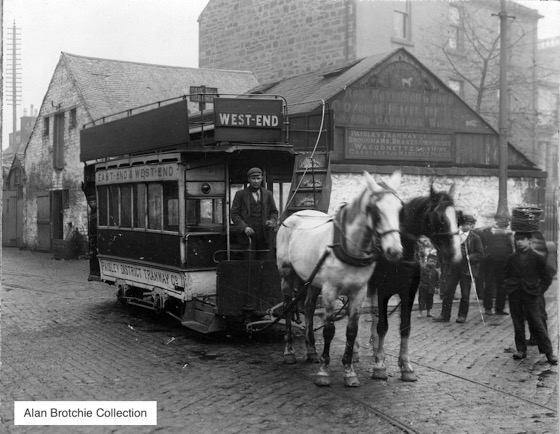
Horsecar No 48 at Incle Street Depot in autumn 1903. Somewhat surprisingly, the new owners' name has been applied to the tram, even though all the horsecars were to be withdrawn within two months. The tramcar itself amply reflects the generally parlous state of the previous enterprise.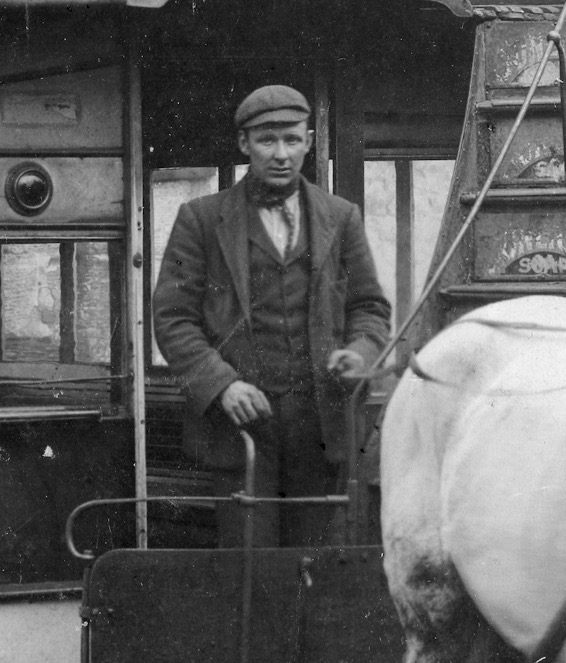
An enlargement of the above photograph showing the driver, who is wearing informal, workmanlike attire.
Motormen and conductors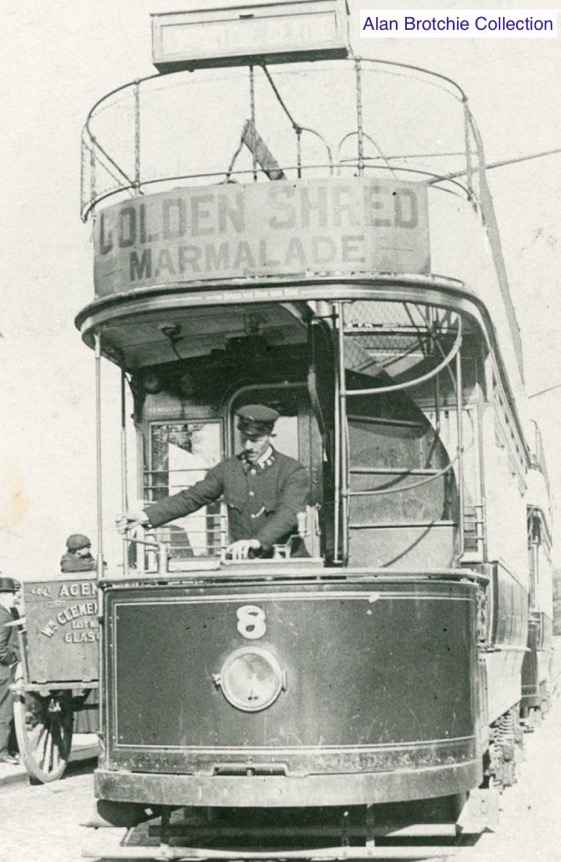
A fairly well-used Tramcar No 8 in Hawkhead Road, indicating that the photograph was taken some while after this vehicle was delivered (1904), possibly in 1905.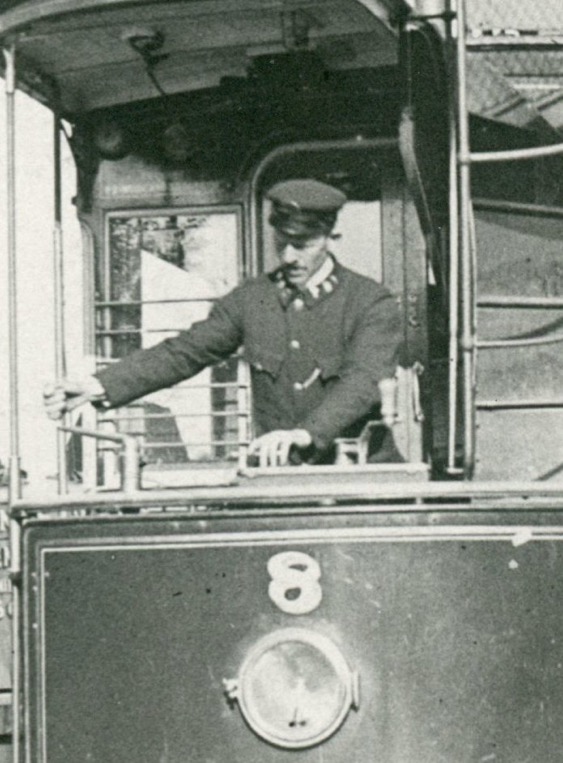
An enlargement of the above photograph showing the motorman, who is wearing a single-breasted jacket with high, fold-over collars; these appear to bear system initials — 'P D T' — on both sides. He is very probably wearing a cap badge, though this cannot be stated with certainty due to the inclination of his head.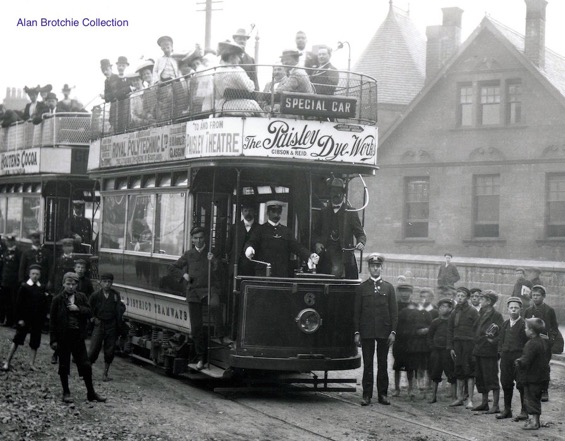
A charming and evocative study of Tramcar No 6 at the head of a cavalcade on the opening day of the Barrhead route, 4th July 1906. Of particular note are the assembled and largely barefoot urchins, the state of the road, and the motorman in his ceremonial white gloves, which can hardly have helped him maintain a sure grip on the controls. In contrast to the horsecars, which bore the title 'Paisley District Tramways Co', the electric cars carried the title 'Paisley District Tramways'.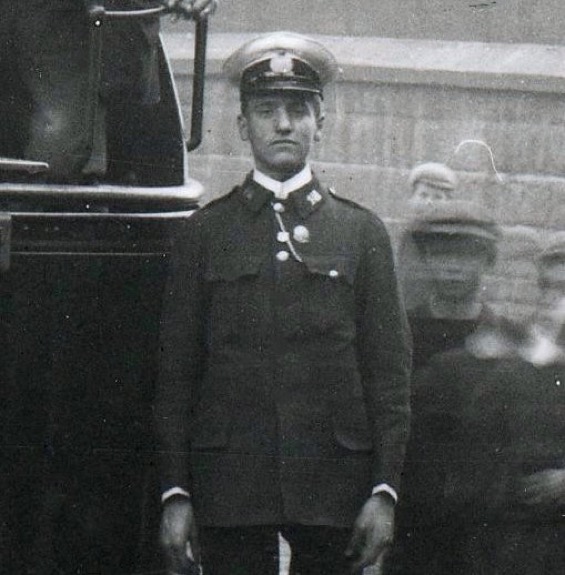
An enlargement of the above photograph showing the figure standing to the right of the tram, who is probably a conductor (Employee No 18). The design of the jacket was probably unique to the PDTCo (amongst UK tramway systems), with the top two buttons visible and the rest hidden (the middle one is not a button). The shape of the prominent cap badge is easily made out. The badge on his left breast is for 'Good Conduct' (see below for an example).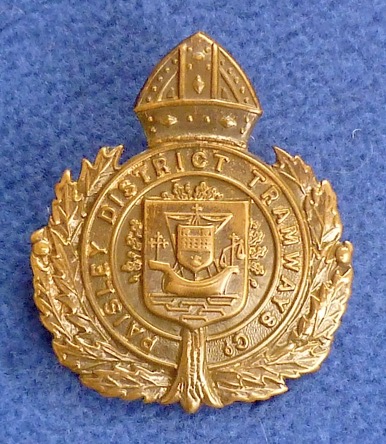
Paisley District Tramways Company cap badge — brass. Author's Collection.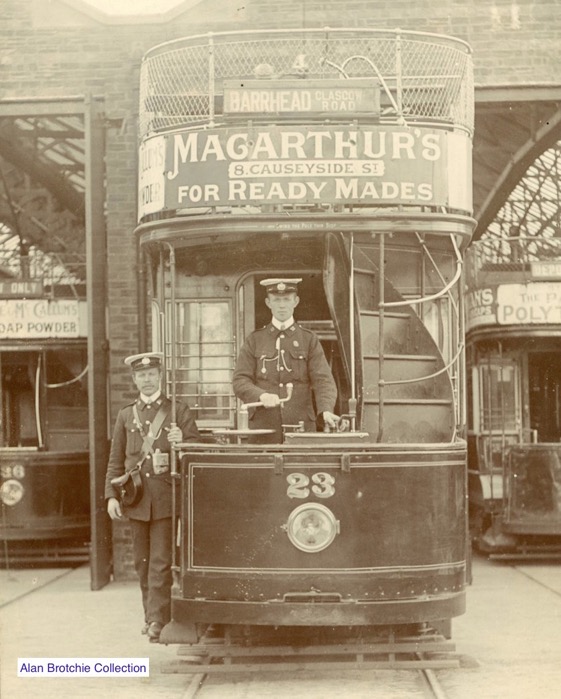
A conductor and a motorman (Employee No 72) pose with Tramcar No 23 at Elderslie depot — photo undated, but probably taken between 1906 and 1908.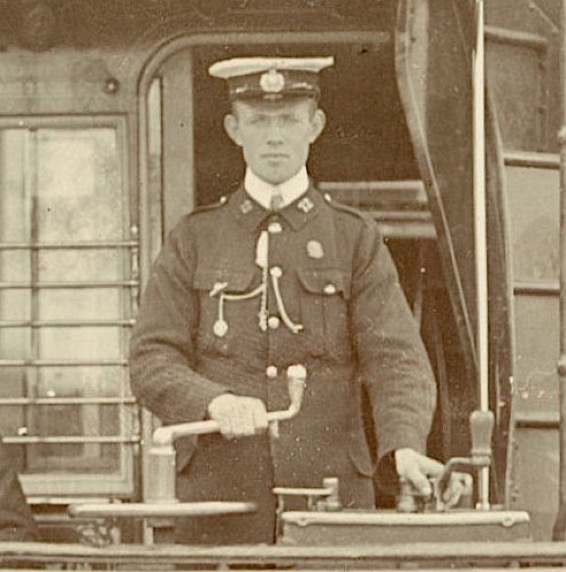
An enlargment of the above photograph showing the motorman, who is wearing a 'Good Conduct' badge on his left breast (see below for an example). 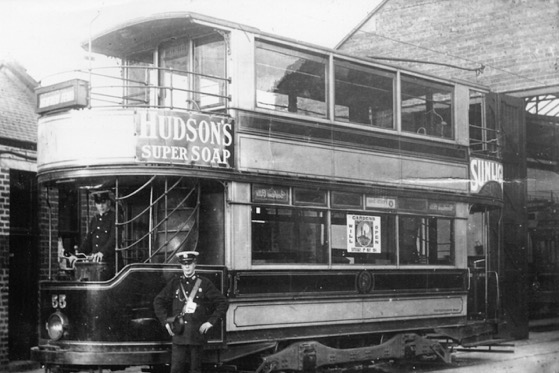
Tramcar No 55 and its crew at Elderslie Depot in May 1914. Photo courtesy of the Tramways and Light Railway Society, with thanks to David Voice.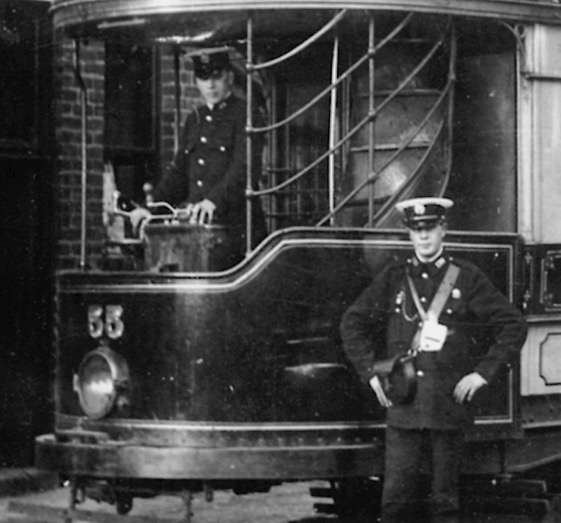
An enlargment of the above photograph showing the motorman and the conductor; the latter is almost certainly wearing a 'Good Conduct' badge on his left breast.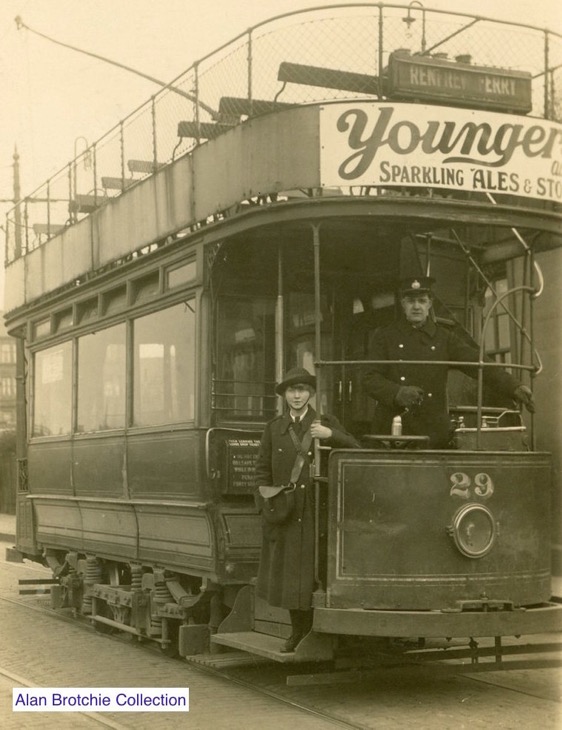
A conductress and a motorman with Tramcar No 29 — photo undated, but almost certainly taken during the Great War or shortly thereafter.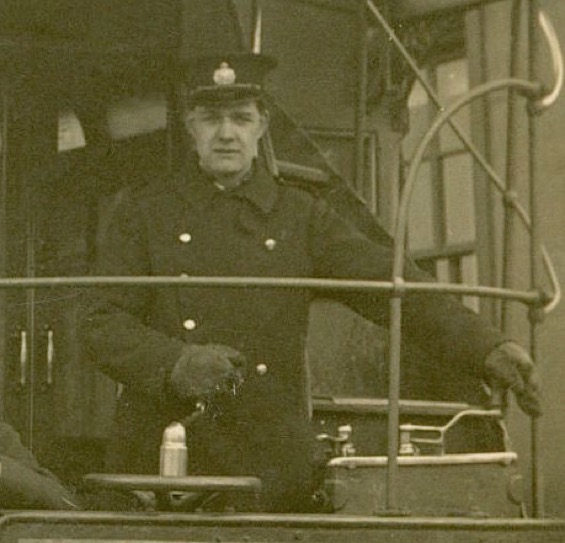
An enlargement of the above photograph showing the motorman, whose greatcoat appears, other than for the buttons, to be completely devoid of insignia.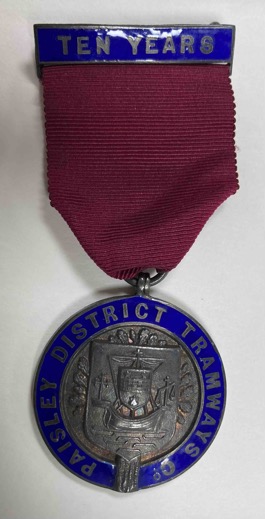
A PDTCo ten years long-service medal. With thanks to the National Tramway Museum.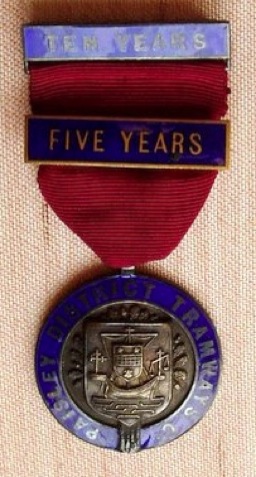
A PDTCo fifteen years long-service medal. With thanks to Alan Brotchie.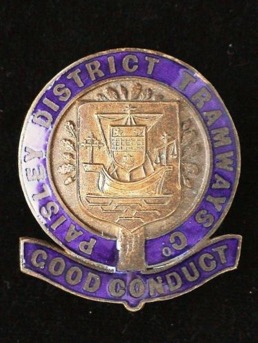
A PDTCo 'Good Conduct' badge from the JR Gaunt Ltd Pattern Book Archive. With thanks to Barry Jobling (eBay: frobisher54).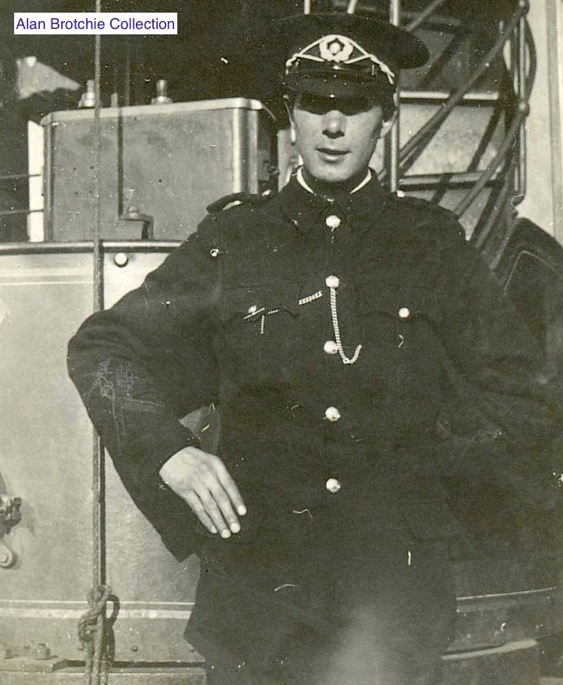
Lastly, a PDTCo employee standing in front of Tramcar No 67, but with an elaborate — and clearly non-standard — cap adornment; it does, however, strongly resemble badges worn by 'Tramways' bands elsewhere in the UK, so he was in all probability a member of Paisley District Tramways Company band.
Senior staff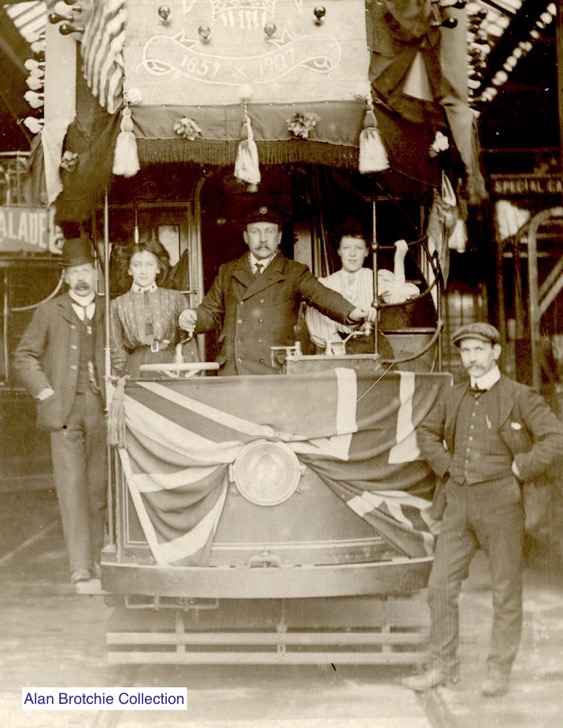
A photograph taken at Elderslie depot taken in 1907 to mark an unknown 50th anniversary. The figure at the controls could possibly be an inspector, though this is far from certain.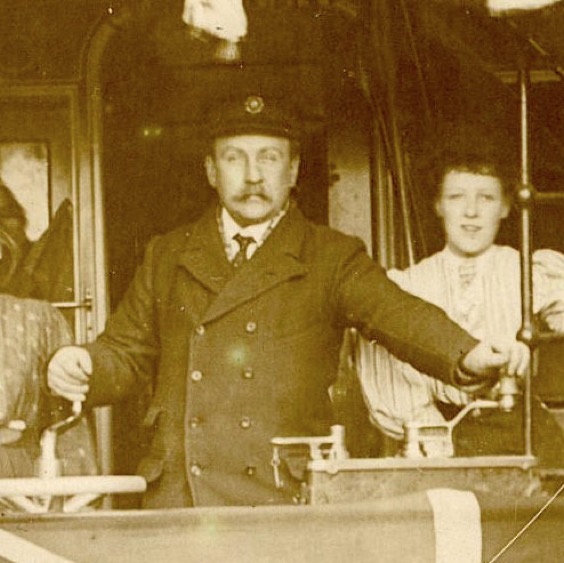
An enlargement of the above photograph showing the figure at the controls. His cap badge is definitely not the standard PDTCo issue.
Female staff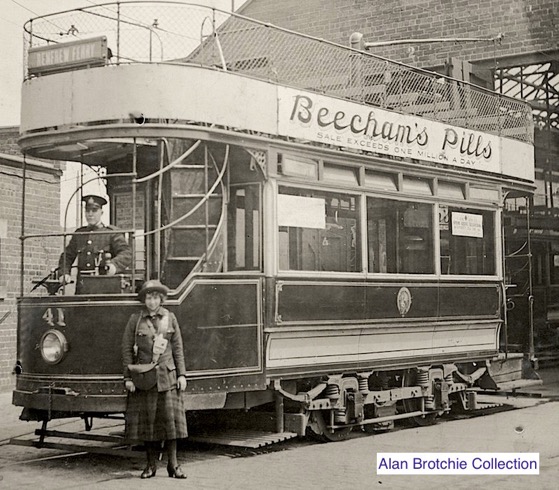
Motorman (Jim Grant) and his conductress pose for the cameraman with Tramcar No 41 at Elderslie Depot — photo undated, but probably taken during the Great War or shortly afterwards.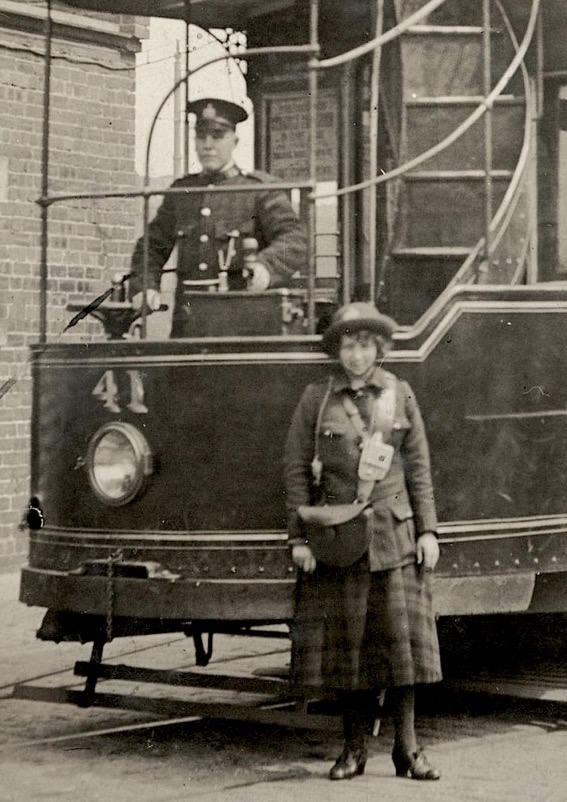
An enlargment of the above photograph, which although slightly out of focus, does show a PDTCo conductress in company-issued tartan skirt.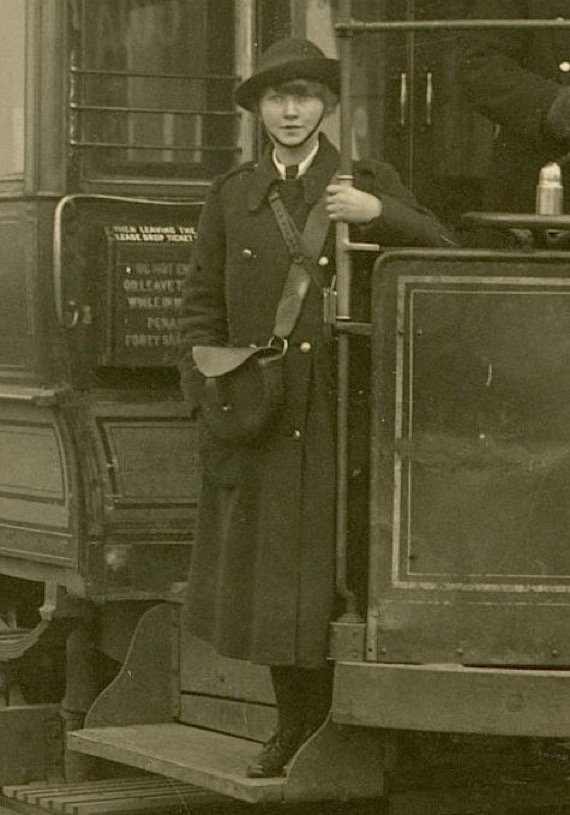
An enlargement of the photograph of Tramcar No 29 above, showing the conductress. Like her motorman (see above), her greatcoat appears not to carry badges of any kind, as does her felt bonnet, though the badge may well be present but obscured.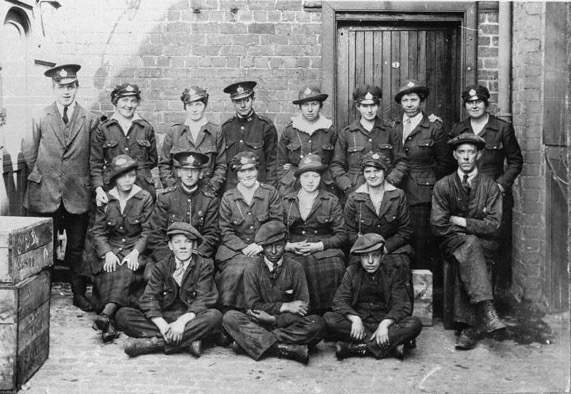
A Great War shot of Elderslie Depot with a rather motley array of tramcar staff (male and female) as well as a number of fitters. The man seated on the right with his arms folded is Sam Wauchop, who was originally from Castlederg in County Tyrone; his future wife — Jean Gibson — is thought to be the lady in the felt hat in the centre of the middle row. My thanks to Joan French, Sam and Jean's granddaughter, for this information. Source unknown.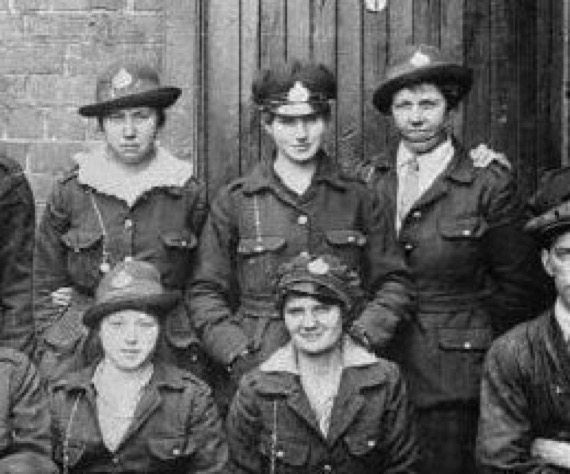
An enlargment of the above photograph showing the two types of headgear worn by the female staff (bonnets and baggy peaked motor caps).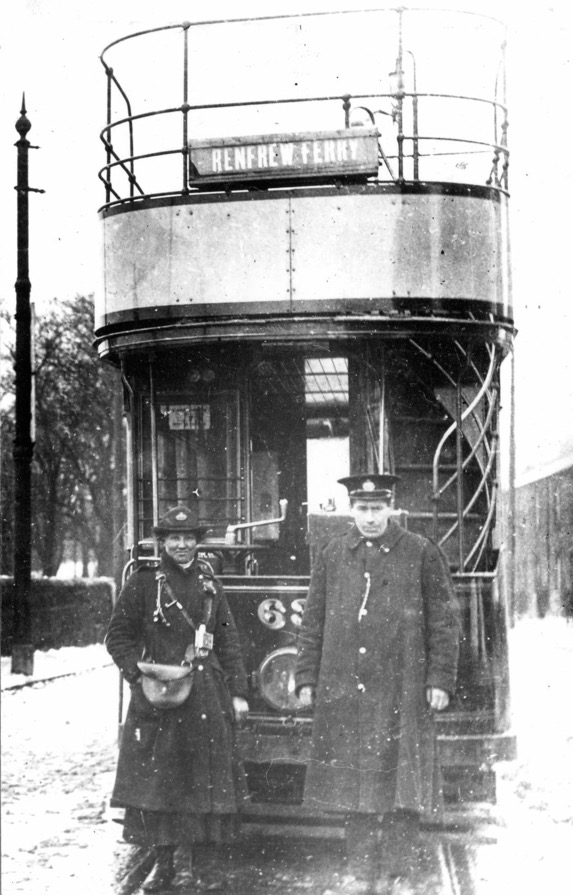
A conductress and a motorman pose in front of Tramcar No 63 with a service to Renfrew Ferry, probably at the Kilbarchan terminus — photo undated, but more than likely taken towards the end of the Great War. The conductress is wearing a double-breasted topcoat with epaulettes. Her hat appears to be a felt bonnet; it bears the standard PDTCo cap badge. Source unknown.